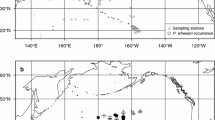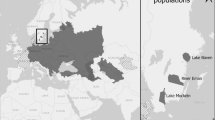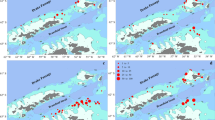Abstract
Giant Australian cuttlefish form a mass spawning aggregation at a single site in northern Spencer Gulf (NSG) in South Australia every austral winter. Samples of cuttlefish were collected from this region over three consecutive years. Analysis of regular growth increments in the cuttlebones of these individuals, revealed a polymorphism in growth pattern for both sexes. Three distinct “bone patterns” were identified based on the variation in increment widths over the lengths of the bones. All bones analysed conformed to one of the three bone patterns, and the increment width patterns were consistent between years. Interpretation of the patterns, suggested that Sepia apama have two alternative life cycles. The first involves rapid juvenile growth during the first summer after hatching, with maturity reached within 7–8 months. These individuals return to spawn in their first year as small individuals. The second life cycle involves much slower juvenile growth during the first summer, with maturity deferred until their second year, when they return to spawn as much larger individuals. Thus, the age compositions of populations of S. apama in the NSG appear to consist of two year classes for both sexes.










Similar content being viewed by others
References
Bandel K, von Boletzky S (1979) A comparative study of the structure, development and morphological relationship of chambered cephalopod shells. Veliger 21:313–354
Beamish RJ, McFarlane GA (1983) The forgotten requirement for age validation in fisheries biology. Trans Am Fish Soc 112:735–743
Bettencourt V, Guerra A (2000) Growth increments and biomineralization process in cephalopod statoliths. J Exp Mar Biol Ecol 248:191–205
Bettencourt V, Guerra A (2001) Age studies based on daily growth increments in statoliths and growth lamellae in cuttlebone of cultured Sepia officinalis. Mar Biol 139:327–334
Brodziak JKT, Macy WK (1996) Growth of long-finned squid, Loligo pealei, in the northwest Atlantic. Fish Bull 94:212–236
Caddy JF (1991) Death rates and time intervals: is there an alternative to the constant natural mortality axiom? Rev Fish Biol Fish 1:109–138
Campana SE (1999) Chemistry and composition of fish otoliths: pathways, mechanisms and applications. Mar Ecol Prog Ser 188:263–297
Campana SE (2001) Accuracy, precision and quality control in age determination, including a review of the use and abuse of age validation methods. J Fish Biol 59:197–242
Campana SE, Neilson JD (1985) Microstructure of fish otoliths. Can J Fish Aquat Sci 42:1014–1032
Campana SE, Thorrold SR (2001) Otoliths, increments, and elements: keys to a comprehensive understanding of fish populations? Can J Fish Aquat Sci 58:30–38
Carrick NA (1997) A preliminary assessment of the by-catch from the Spencer Gulf prawn fishery, South Australian Fisheries Assessment Series 97/02. SARDI Aquatic Sciences, Adelaide
Challier L, Royer J, Robin JP (2002) Variability in age-at-recruitment and early growth in English Channel Sepia officinalis described with statolith analysis. Aquat Living Resour 15:303–311
Challier L, Dunn MR, Robin JP (2005) Trends in age-at-recruitment and juvenile growth of cuttlefish, Sepia officinalis, from the English Channel. ICES J Mar Sci 62:1671–1682
Choe S (1963) Daily age markings on the shell of cuttlefishes. Nature 197:306–307
Denton EJ, Gilpin-Brown JB (1961) The buoyancy of the cuttlefish, Sepia officinalis (L.). J Mar Biol Assoc UK 41: 319–342
Gales R, Pemberton D, Lu CC, Clarke MR (1993) Cephalopod diet of the Australian fur seal: variation due to location, season and sample type. Aust J Mar Freshw Res 44:657–671
Hall KC, Fowler AJ (eds) (2003) The fisheries biology of the cuttlefish Sepia apama Gray, in South Australian waters. Final Report to FRDC (Project No. 98/151). SARDI Aquatic Sciences, Adelaide, p 277
Hatfield EMC, Rodhouse PG (1994) Migration as a source of bias in the measurement of cephalopod growth. Antarct Sci 6:179–184
Hewitt RA, Stait B (1988) Seasonal variation in septal spacing of Sepia officinalis and some Ordovician actinocerid nautiloids. Lethaia 21:383–394
Jackson GD, Alford RA, Choat JH (2000) Can length frequency analysis be used to determine squid growth?—an assessment of ELEFAN. ICES J Mar Sci 57:948–954
Kim ZG, Hong BQ (1991) Study on possible group separation of cuttlefish Sepia esculenta Hoyle in Korean waters. Bull Natl Fish Res Dev Agency (Korea) 45:71–84
Le Goff R, Gauvrit E, Du Sel GP, Daguzan J (1998) Age group determination by analysis of the cuttlebone of the cuttlefish Sepia officinalis L. in reproduction in the Bay of Biscay. J Molluscan Stud 64:183–193
Lipinski MR (1998) Cephalopod life cycles: patterns and exceptions. In: Payne AIL, Lipinski MR, Clarke MR, Roeleveld MAC (eds) Cephalopod biodiversity, ecology and evolution. S Afr J Mar Sci 15:439–447
Lu CC (1998) A synopsis of Sepiidae in Australian waters (Cephalopoda: Sepioidea). In: Voss NA, Vecchione M, Toll RB, Sweeney MJ (eds) Systematics and biogeography of cephalopods. Smiths Contr Zool 586:159–190
Macy WK III (1995) The application of digital image processing to the aging of long-finned squid, Loligo pealei, using the statolith. In: Secor DH, Dean JM, Campana SE (eds) Recent developments in fish otolith research. South Carolina Press, USA, pp 283–302
Macy WK, Brodziak JKT (2001) Seasonal maturity and size at age of Loligo pealeii in waters of southern New England. ICES J Mar Sci 58:852–864
Natsukari Y, Hirata S, Washizake M (1991) Growth and seasonal change of the cuttlebone characters of Sepia esculenta. In: Boucaud-Camou E (ed) La seiche, The cuttlefish. 1st international symposium on the cuttlefish, Sepia. Centre de Publications de L’Université de Caen, Caen, France, pp 49–67
Nunes RA, Lennon GW (1986) Physical property distributions and seasonal trends in Spencer Gulf, South Australia: an inverse estuary. Aust J Mar Freshw Res 37:39–53
Nunes Vaz RA, Lennon GW, Bowers DG (1990) Physical behaviour of a large, negative or inverse estuary. Cont Shelf Res 10:277–304
Packard A (1972) Cephalopods and fish: the limits of convergence. Biol Rev 47:241–307
Pannella G (1971) Fish otoliths: daily growth layers and periodical patterns. Science 173:1124–1127
Pierce GJ, Guerra A (1994) Stock assessment methods used for cephalopod fisheries. Fish Res 21:255–285
Ré P, Narciso L (1994) Growth and cuttlebone microstructure of juvenile cuttlefish, Sepia officinalis L., under controlled conditions. J Exp Mar Biol Ecol 177:73–78
Richard A (1969) The part played by temperature in the rhythm of formation of markings on the shell of cuttlefish (Sepia officinalis L.) (Cephalopoda, Mollusca). Experientia 25:1051–1052
Rodhouse PG, Hatfield EMC (1990) Age determination in squid using statolith growth increment. Fish Res 8:323–334
Tabachnick BG, Fidell LS (2001) Using multivariate statistics. Allyn & Bacon, Needham Heights, p. 966
von Boletzky S (1974) Effets de la sous-nutrition prolongée sur le développement de la coquille de Sepia officinalis L. (Mollusca, Cephalopoda). Bull Soc Zool Fr 99:667–673
von Boletzky S (1983) Sepia officinalis. In: Boyle PR (ed) Cephalopod life cycles, vol. I: species accounts. Academic, London, pp 31–52
von Boletzky S, Overath H (1991) Shell fracture and repair in the cuttlefish Sepia officinalis. In: Boucaud-Camou E (ed) La seiche, The cuttlefish. 1st international symposium on the cuttlefish, Sepia. Centre de Publications de L’Université de Caen, Caen, France, pp 69–78
Voss NA (1983) A review of cephalopod fisheries biology. Mem Mus Vic 44:229–241
Zar JH (1999) Biostatistical analysis. Prentice-Hall, Upper Saddle River, p 663
Acknowledgements
We gratefully acknowledge funding from the Fisheries Research and Development Institute and logistical support from the South Australian Research and Development Institute and the University of Adelaide. This study was completed while Karina Hall was supported by an Australian Postgraduate Award Scholarship. We sincerely thank Neil Carrick and the Spencer Gulf Prawn Trawl Fleet and the Captain and crew of MRV Ngerin for assistance in the collection of cuttlefish samples; Dave McGlennon and Keith Jones for sourcing funding for the project; and Dave Short, Paul Jennings, Sangeeta Taylor, Bruce Jackson, Val Boxall, Dave Fleer and Sonja Venema for expert assistance in field operations. We also thank two anonymous reviewers for their time and valuable comments on an earlier version of this manuscript.
Author information
Authors and Affiliations
Corresponding author
Rights and permissions
About this article
Cite this article
Hall, K.C., Fowler, A.J. & Geddes, M.C. Evidence for multiple year classes of the giant Australian cuttlefish Sepia apama in northern Spencer Gulf, South Australia. Rev Fish Biol Fisheries 17, 367–384 (2007). https://doi.org/10.1007/s11160-007-9045-y
Published:
Issue Date:
DOI: https://doi.org/10.1007/s11160-007-9045-y




